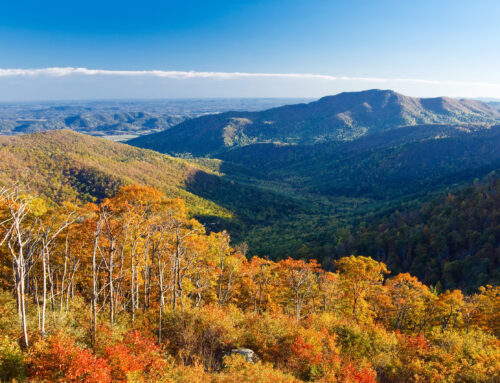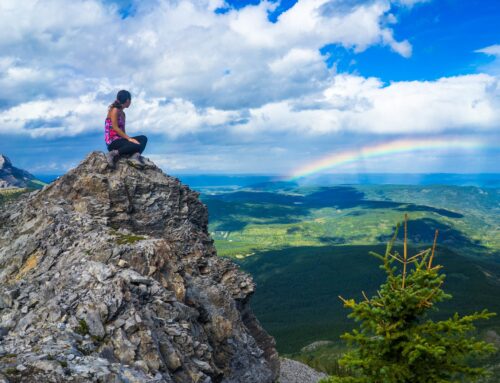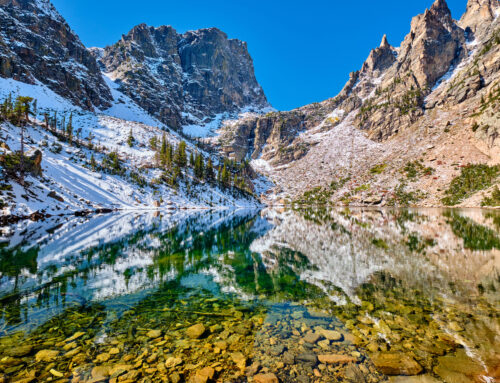Updated November 1, 2020
Grand Teton National Park is one of the most scenic and widely photographed national parks in the United States, and for good reason – the landscapes here are strikingly beautiful. While many people choose to drive through and observe its natural beauty along the roadways, the absolute best way to experience these jagged peaks and placid lakes is by hiking in Grand Teton National Park. To help you make the most of your time in the park, we’ve created this list of the best hikes in Grand Teton that are suitable for all levels of adventurers!

Easy Hiking in Grand Teton National Park
Leigh Lake
- Trail Length: 7 miles (out-and-back)
- Elevation Gain: 110 feet
For a quieter, more peaceful trail than some of the other lake hikes in Grand Teton National Park, Leigh Lake is a wonderful and family-friendly option. Situated north of Jenny Lake and String Lake, Leigh Lake boasts stunning views of the Tetons across a serene lakeside, with dirt paths winding through pine forests and root-laced shorelines.
Elevation gain on this trail is minimal, making it ideal for beginner hikers or families wanting an easy and scenic spot to take a walk. This trail is out-and-back, so you can shorten this hike based on your time and distance preferences. Alternatively, you can combine the Leigh Lake Trail with the String Lake Loop (see below) for a longer adventure.
How to get there: Head to the North Side of Jenny Lake parking area, and park in the section closest to the String Lake trail head. From there, follow signs to Leigh Lake trail head and begin your hike there.
String Lake Loop
- Trail Length: 3.7 miles
- Elevation Gain: 262 feet
As a sister lake to both Jenny Lake and Leigh Lake, String Lake is a small, scenic waterway that’s popular with both hikers and paddlers. For hikers, there’s a loop trail around the shore of the lake that’s one of the best easy hikes in Grand Teton for all levels of hikers. Along the lake, you’ll find dirt trails that wind through wooded areas, offering stunning views of the Tetons reflecting off the mountains.
As the trail runs mostly through the forest, it’s a great hike to do when the sun is high in the sky. If you’re looking for a longer adventure, combine this trail with Leigh Lake or Jenny Lake to get a variety of views of the iconic Teton ridge.
How to get there: Head to the North Side of Jenny Lake parking area, and park in the section closest to the String Lake trail head.
Flagg Canyon
- Trail Length: 5.1 miles
- Elevation Gain: 324 feet
For a scenic walk along the Snake River, the Flagg Canyon trail on the north side of the park is a great place for hiking in Grand Teton. Featuring a pretty waterfall and lots of riverfront and forest views, this leisurely pathway is a great adventure through the north side of Grand Teton. Wildflowers, pine trees, and wildlife viewing opportunities will greet you on these dirt pathways.
If you’re staying at Flagg Ranch Campground, it’s a nearby trail that’s conveniently accessed without a car. Note that because this trail is close to the river, you should make sure to use bug spray and opt for long sleeves/pants, as the mosquitoes here can get vicious during the summertime.
How to get there: The trail head is located just south of the entrance to Flagg Ranch off of Hwy 89. You’ll need to cross under a bridge to access the rest of the trail.

Two Ocean Lake
- Trail Length: 6.1 miles
- Elevation Gain: 462 feet
For a lesser-known lake trail that boasts beautiful views of the Tetons, Two Ocean Lake is a wonderful option for hiking in Grand Teton. This flat, easy trail spans 6.1 miles along the perimeter of the lake, offering spectacular views of the mountains as well as the surrounding forests, especially early in the day when the water is still and mirror-like.
The area is also known for abundant wildlife, including bears (so enjoy, but don’t forget to remain alert and keep bear spray with you at all times).
How to get there: Turn onto Pacific Creek Road from Hwy 89, then turn left onto Two Ocean Lake Road. Then, follow the road to the end where you can park and begin the hike.

Taggart Lake Loop
- Trail Length: 4.1 miles
- Elevation Gain: 429 feet
Taggart Lake, located south of Jenny Lake, is a scenic lake located at the foot of the Tetons. For morning hikes with a view, there are few hikes we’d recommend more than Taggart Lake. It’s a perfect place for beginners to go hiking in Grand Teton, with a 4.1 mile loop that winds through the forest to reach the lakeside. At the lake itself, you can enjoy glassy reflections of the mountains on the teal blue lake, especially early in the morning when the water is still.
Note that the parking lot for Taggart Lake is quite small and can get crowded, so we’d recommend getting there early in the morning for the best views and the smallest crowds. Additionally, this hike can be combined with a hike to Bradley Lake for a longer, more challenging adventure.
How to get there: From Highway 89 near the Moose entrance, look for signs that say “Taggart Lake” on the side of the road closest to the mountains.
Colter Bay Lakeshore Trail
- Trail Length: 2.5 miles
- Elevation Gain: Minimal
Colter Bay is a campground, lodge, and scenic lake all in one, and one of our favorite ways to enjoy it is by hiking one of the main trails in the area. For hikers that want a shorter adventure, the Colter Bay Lakeshore Trail is a fantastic option that’s suitable for all levels. This popular trail boasts 2.5 miles of beautiful lakeside and mountain views spanning a small peninsula lined with pine trees that juts out into the water.
Unlike many of the hikes on our list, this trail is paved, so it’s suitable for families with strollers or wheelchairs. It’s also easily accessed from the Colter Bay parking lot, where there is plenty of space throughout the day for visitors to park.
How to get there: Enter the Colter Bay Village area and park near the Colter Bay Amphitheater.

Colter Bay Hermitage Point
- Trail Length: 9.6 miles
- Elevation Gain: 738 feet
For a longer, more involved hike near Colter Bay, Hermitage Point is a fantastic spot for hiking in Grand Teton. This trail starts at Colter Bay Village and brings hikers along forested dirt paths along the lakefront, down south to a quiet wooded peninsula where you can catch incredible, breathtaking views of the mountains across the lake. You can combine this with the Lakeshore Trail for an extra-long adventure, as the two trails do not overlap.
As this hike is on the long side, we’d strongly recommend bringing and reapplying bug spray often, as the mosquitos can get very aggressive, especially in the summer. We’d also strongly recommend bringing bear spray, as there have been several bear sightings along the trail.
Phelps Lake
- Trail Length: 7 miles
- Elevation Gain: 725 feet
If you’re looking for a lake that has views of the iconic Teton mountain range, but is a little less crowded, Phelps Lake is one of the best Grand Teton hikes for all levels. At 7 miles, it’s definitely one of the longer easy hikes on our list, but is much less crowded than nearby Jenny Lake and boasts beautiful (but different) views.
This loop trail runs around the perimeter of Phelps Lake, through mostly shaded and wooded areas. It’s suitable for hikers of all skill levels, and is a good option for a hike later in the day as direct sun exposure is minimal.
How to get there: From Moose-Wilson Road, turn off at the Phelps Lake trailhead entrance and park at the end of the road.

Schwabacher’s Landing
- Trail Length: 1.8 miles
- Elevation Gain: Minimal
Quite possibly the most scenic and famous spot in Grand Teton National Park for photographers is Schwabacher’s Landing. Located on a small, slow-moving creek, this trail boasts jaw-dropping views of the iconic Grand Teton peaks reflecting off the water. While many people simply park and enjoy the views nearby, there’s a 1.8-mile trail that accompanies this viewpoint, where you can catch lots of different perspectives of the mountains amidst the dense evergreen forests.
For excellent lighting and views with few people, sunrise is the best time to head to Schwabacher Landing. You’ll have the opportunity to see the mountains glow orange and gold in the morning sun, their snowy peaks reflecting off the water from the creek. If you go later in the day, the afternoon haze may make the mountain views a little more foggy.
How to get there: Turn onto Schwabacher Road from Hwy 26-89 and continue all of the way down the gravel road to the trail head.

Moderate Hikes in Grand Teton National Park
Hidden Falls & Inspiration Point
- Trail Length: 2 miles
- Elevation Gain: 410 feet
As one of the most popular hikes in Grand Teton National Park, you won’t likely find solitude and tranquility on the Hidden Falls and Inspiration Point trail. However, you will find an accessible moderate hike (just under 2 miles) that has a variety of landmarks, including waterfalls, forests, and a sweeping viewpoint of Jenny Lake.
For families wanting a bit of an extra challenge, this moderate short hike is a popular and scenic option. However, our personal opinion is that the Inspiration Point viewpoint was a little underwhelming, and that this hike is best paired with a continuation into Cascade Canyon (see below).
For the least crowded trails, take the first Jenny Lake boat shuttle at 7 AM (leaves from a boat dock near Jenny Lake visitor center, $18 ticket round trip). If you want to extend your hike beyond the 2 miles of this trail, you can buy a one-way ticket across the lake and then hike the Jenny Lake trail back to the parking lot.
How to get there: Enter the Jenny Lake South area, drive past the visitor center, and park by the entrance to the Jenny Lake Trail. From there, you can walk to the boat shuttle dock and purchase your ticket for Inspiration Point and Hidden Falls.
Jenny Lake
- Trail Length: 7.7 miles
- Elevation Gain: 728 feet
Jenny Lake is one of the most iconic and highly-trafficked areas of Grand Teton National Park. For those wanting to avoid large crowds, this trail probably isn’t for you. However, if you go early in the day and hike counter-clockwise, you can enjoy this gorgeous lake trail with much fewer crowds. As one of the most popular places for hiking in Grand Teton National Park, we’d recommend arriving before 8 AM.
Once you’re at the trail head, you have a few options: you can hike the full 7.7-mile trail, or you can take the Jenny Lake boat shuttle across the lake and walk back. Shuttle fares are $10 one way or $18 round trip.
How to get there: Enter the Jenny Lake South area, drive past the visitor center, and park by the entrance to the Jenny Lake Trail.

Cascade Canyon
- Trail Length: 9.7 miles
- Elevation Gain: 1,128 feet
One of our top picks for hikes in Grand Teton is Cascade Canyon, a moderate trail through one of the major canyon areas in Grand Teton National Park. This trail passes by Hidden Falls and Inspiration Point, so it’s a fantastic day hike to pair with a trip to Jenny Lake. Along this 9.7-mile trail, you’ll see gorgeous mountain and glacier views. The beginning of the trail is a pretty steep uphill, but the rest has rolling hills across a gravel/rocky path.
A nice aspect of the Cascade Canyon trail is that it’s out-and-back, so you can make your adventure as long or as short as you’d like to go. In our opinion, it’s worth hiking up at least a little bit past Inspiration Point to enjoy some of the striking views of Cascade Canyon.
How to get there: Enter the Jenny Lake South area, drive past the visitor center, and park by the entrance to the Jenny Lake Trail. From there, you can walk to the boat shuttle dock and purchase your ticket to the trail head for Inspiration Point and Cascade Canyon.
Taggart Lake to Bradley Lake Loop
- Trail Length: 6 miles
- Elevation Gain: 761 feet
If you’re looking for a moderately challenging and stunningly beautiful hike, Taggart Lake and Bradley Lake Loop is an excellent option. With serene alpine lakes and views of the majestic Tetons in the distance, this trail is perfect for hikers of all levels looking for a bit of a challenge with magnificent rewards. If you go early enough, you can catch some breathtaking reflections of the mountains in the still waters of the lakes before the mid-day wind picks up.
As we mentioned in the Taggart Lake section, parking is limited in this part of the park, so we’d recommend beginning this hike before 8 AM. Plus, the light in the morning against the mountains is an incredible sight to see.
How to get there: From Highway 89 near the Moose entrance, look for signs that say “Taggart Lake” on the side of the road closest to the mountains.

Signal Mountain
- Trail Length: 8.3 miles
- Elevation Gain: 1,184 feet
Signal Mountain is a mountaintop that overlooks Jackson Lakes and the iconic, snow-capped Teton range. A popular spot for watching sunrise and sunset, the 8.3-mile Signal Mountain trail is a fun hike to a pretty viewpoint.
The catch? This trail ends at the summit of Signal Mountain…which people can also drive to. So, if you’re looking for a remote wilderness hike with epic, exclusive views, this hike probably isn’t the best one of you. However, if you’re wanting a moderately challenging hike to one of the park’s most stunning viewpoints, we’d say to go for it!
How to get there: Park near the Signal Mountain lodge, then take the trail that begins on Signal Mountain Marina Road.
Aspen Ridge Loop
- Trail Length: 5.7 miles
- Elevation Gain: 780 feet
For a forested trail that’s off the beaten path, Aspen Ridge is a wonderful spot for hiking in Grand Teton National Park. This 5.7-mile loop trail winds through the forest, passing by scenic alpine lakes, beautiful viewpoints, and tons of wildlife viewing areas. This is one of the lesser-known hikes in Grand Teton, so you can expect much smaller and more sparse crowds, even during the popular summer season.
How to get there: Park at the trailhead for Phelps Lake, then follow signs for Aspen Ridge.

Difficult Hikes in Grand Teton National Park
Lake Solitude
- Trail Length: 16 miles
- Elevation Gain: 2,637 feet
Lake Solitude is one of the most popular challenging hikes in Grand Teton, but the stunning views along the trail are absolutely worth the effort. You’ll pass through Hidden Falls, Inspiration Point, and Cascade Canyon, ending at Lake Solitude and giving you a quadruple-whammy of hikes all in one! Hikers rave that the Lake Solitude trail is perhaps the most beautiful and scenic hike in all of Grand Teton…but you’ll have to do the hike to decide for yourself.
At 16 miles of trail (out and back), this is not a hike for beginners or those looking for a short adventure. Most people clock in between 7.5 and 9 hours from beginning to end for Lake Solitude, so you’ll need a full day to complete the hike. However, if you’re willing to put in the work and exercise, the views are some of the most picturesque and outstanding in the entire park.
How to get there: Begin at Jenny Lake South, where you can take the boat shuttle to the trail head. Alternatively, you can park at Jenny Lake North/String Lake and walk to the trail head via the Jenny Lake trail.

Delta and Amphitheater Lakes
- Trail Length: 9 miles
- Elevation Gain: 2,329 feet
Of all of the challenging hikes in Grand Teton, Delta Lake is one of the most beautiful (and popular). This strenuous trail traverses forests, switchbacks, and some stunning viewpoints. Delta Lake itself is one of the most picturesque spots in the the entire Grand Teton park area.
It’s best to do this hike in the early morning to ensure you can find a parking space. The sun can get very hot and direct, especially in the non-shaded areas, so be sure to pack plenty of sunscreen and bug spray for your hike.
How to get there: Park at the trail head for Lupine Meadows, then begin the hike there. We’d recommend using AllTrails to ensure you’re on the right path for Delta Lake, otherwise, it can be very difficult to find.
Garnet Canyon to Lower Saddle
- Trail Length: 12.3 miles
- Elevation Gain: 5,321 feet
Scramblers and climbers, rejoice! The Garnet Canyon to Lower Saddle hike is popular for its technical aspects, namely scree fields, scrambling/bouldering, and even opportunities for traditional rock climbing. As this is the path that most people who climb Grand Teton take to get to the base, it offers stunning views of the iconic mountains surrounding the namesake peak.
This hike is not for the faint of heart, as many folks will name this one as one of the most difficult spots for hiking in Grand Teton. Come prepared with crampons and bear spray, as ice/snow and wildlife are both significant threats on this trail.
How to get there: Begin the trail on the Lupine Meadows Access trail head area.

Static Peak
- Trail Length: 16.8 miles
- Elevation Gain: 5,423 feet
Static Peak is a beloved trail in Grand Teton for experienced hikers and those looking to bag a gorgeous peak in the park. Many hikers refer to it as a hidden favorite, as its difficulty and length make this summit accessible only to experienced folks looking for a challenge. Along the way, you’ll find steep ascents and plenty of switchbacks, with a rocky peak that’s a gorgeous spot for photos or a leisurely summit snack.
At around 17 miles, this is a full day hike that leads you all the way to the peak of Static Mountain. It can also be paired with the Albright Peak for an extra long, strenuous, and rewarding adventure.
How to get there: Turn onto White Grass Trail Head Road (near Phelps Lake), then stay left to arrive at the Static Peak trail head.
Grand Teton Loop
- Trail Length: 31.6 miles
- Elevation Gain: 6,909 feet
For those wanting a multi-day wilderness backpacking experience, Grand Teton Loop is the iconic 31.6-mile backpacking circuit in the park. This trail winds through the area near Jenny Lake, offering unparalleled views of the Grand Teton peak and the mountains nearby. This hike combines some of the best views in the entire park, and shouldn’t be missed if backcountry is your style!
To do this multi-day hike, you’ll need to reserve a wilderness permit in advance or in person at the national park’s office and come equipped with your own backpacking gear. There are designated camping areas that are available to backcountry hikers, so be sure to consult the park rangers for the most up to date information.
How to get there: Begin the trail at the Jenny Lake South trail head, where you can park your car overnight if you are backpacking.

Additional Resources for Hiking in Grand Teton National Park
What to Bring
- Breathable hiking clothes – For warmer hikes, you’ll want to wear a sweat-wicking shirt and breathable pants, like these Patagonia hiking shorts for men and women. For cold-weather hikes, we recommend dressing in layers, including merino wool baselayers for men and women, a down puffer jacket for men and women, and a Northface waterproof outer shell for men and women (a must for hiking in Seattle). And don’t forget a pair of the best women’s and men’s hiking socks!
- Trekking poles – You won’t need these for every single hike, but we suggest throwing them in your car just in case. We recommend the Black Diamond Trail Ergo cork trekking poles, which are lightweight, easy to transport, and durable.
- Water bottle – Having water available at all times is a huge must. To limit disposable plastic, we recommend bringing your own refillable water bottle. We’re obsessed with Hydro Flask water bottles because they keep water cold for hours.
- Sunscreen and bug spray – Sweatproof sunscreen and DEET bug spray can help you avoid sunburn and bug bites, two of hiking’s most annoying after-effects. Our favorite kind of sunscreen is Sun Bum, as it is free of harsh chemicals and safe for marine life, including coral reefs.
- A brimmed hat or cap – The sun can be brutal in open hikes, so always pack a brimmed hat or cap for day hikes in the sunshine.
- Emergency blanket and first aid kit – We’d strongly recommend bringing a first aid kit and a lightweight emergency blanket on every hike. Why? Because the unfathomable can happen, and it’s always best to play it safe.
- Durable day pack – A durable day pack is the perfect spot to stash all your hiking gear. While any backpack will do, we recommend the Osprey Tempest 20 or the Talon 22 day packs because they’re comfortable and breathable for long hikes. For more information, check out our best day packs for any terrain guide.







